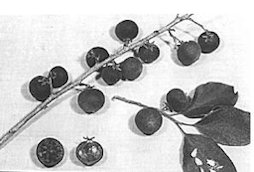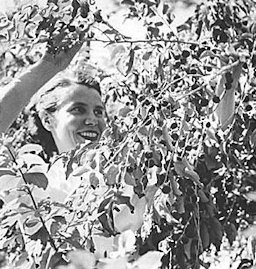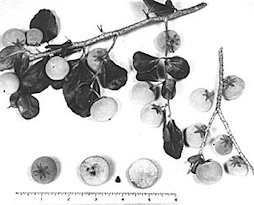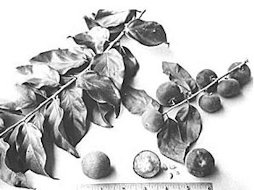From the book
Fruits of Warm Climates
by Julia F. Morton
Kitembilla
Dovyalis hebecarpa Warb.
Aberia gardneri Clos.
Roumea hebecarpa Gard.
SALICACEAE
Somewhat better-known than the kei apple, q.v., the ketembilla, Dovyalis hebecarpa Warb. (syns. Aberia gardneri Clos.; Roumea hebecarpa
Gard.), is often called Ceylon gooseberry; sometimes ketambilla, or
kitembilla; and it is known as aberia in Cuba and Central America.
Description
The shrub or
small tree reaches no more than 15-20 ft (4.5-6 m) in height but its
long, slender, arching, wide-spreading branches may cover 30 ft (9 m)
of ground. Sharp spines to 1 1/2 in (4 cm) long, are plentiful on the
trunk and lower branches. The alternate leaves are elliptical to ovate,
pointed, 2 3/4 to 4 in (7-10 cm) long, wavy-margined, gray-green,
finely velvety, with pinkish, woolly petioles, and thin in texture.
Male, female and hermaphrodite flowers are borne on separate trees.
They are petalless, greenish-yellow, nearly 1/2 in (1.25 cm) wide and
clustered in the leaf axils. The fruit, borne in great abundance, is
globose, 1/2 to 1 in (1.25-2.5 cm) wide. Its thin, bitter skin turns
from somewhat orange to dark purple on ripening and is coated with
short, grayish-green, velvety hairs, unpleasant in the mouth. The pulp
is very juicy, extremely acid, purple-red, enclosing 9 to 12 hairy
seeds about 1/4 in (6 mm) long.

Fig. 84: Ripe fruits of the ketembilla are furry-skinned, extremely acid and slightly bitter.
Origin and
Distribution
The
ketembilla is native to Ceylon. It was introduced into the United
States by Dr. David Fairchild and was one of the few fruits he admitted
he never liked very much. The first fruiting specimens in the western
hemisphere were apparently those growing in southern Florida. P.J.
Wester carried seeds to the northern islands of the Philippines where
it began fruiting in 1916. From Florida, also, the plant was introduced
into the Atkins Garden of Harvard University at Cienfuegos, Cuba. Seeds
from the Garden were shipped to the Hawaiian Sugar Planters'
Association in 1920, and to the Lancetilla Experimental Garden at Tela,
Honduras, in 1927. Seeds from Florida were supplied to the Mayaguez and
Trujillo Experimental Stations in Puerto Rico where the plants were 16
ft (5 in) high by 1929 and 1930. Plants were distributed widely
throughout the Hawaiian Islands and use of the fruits was officially
encouraged.
Florida pioneers grew the species and utilized the
fruits until the plants took up too much space. When South Florida
began to develop rapidly after World War II, most people had no room
for such an aggressive plant. One enthusiast maintained a small
commercial plot in West Palm Beach for juice production.
In
1935, horticulturists in Israel imported seeds from Ceylon and plants
grew and fruited well in a variety of locations. Commercial
exploitation was anticipated but was suspended during World War II
because of the shortage of sugar for preserving.

Fig. 85: Formerly grown for jelly-making, the too-vigorous, productive ketembilla or Ceylon gooseberry (Dovyalis hebecarpa) is no longer planted in southern Florida.
Climate
In the Philippines,
the ketembilla flourishes from sea-level to 2,600 ft (800 m). In
Malaya, it is found from near-sea-level up to 4,000 ft (1,200 m). It
has never survived at Singapore. Fruiting is not consistent at Tela,
Honduras. However, it does do well planted at appropriate elevations in
either dry or moist climates.
Soil
In Florida, the plant
grows entirely too vigorously on sand or limestone, but a rich soil is
best for maximum fruit production and plenty of water is desirable
during fruit development.
Season
In Israel, fruit
ripens from winter to spring. In Florida, there are two crops a
year–spring and fall, but the fruits may be infested with the larvae of
the Caribbean fruit fly, Anastrepha suspensa, and unusable.
Food Uses
In Florida, in the
past, the ketembilla was used primarily for jelly. Recipes developed in
Hawaii include juice, spiced jelly, ketembilla-papaya jam,
ketembilla-guava jelly, and ketembilla-apple butter. In Israel, the
fruit is valued mainly as a source of jelly for export.
| Food
Value Per
100 g of Edible Portion* |
| Moisture
|
81.9-83.6 g |
| Protein |
0.174-0.206 g |
|
Fat |
0.64-1.02 g |
| Crude
Fiber |
1.7-1.9 g |
| Ash |
0.61-0.63 g
| | Calcium |
12.6-13.3 mg
| | Phosphorus |
24.5-26.8 mg |
| Iron |
0.91-1.41 mg |
| Carotene |
0.125-0.356 mg
|
| Thiamine |
0.017 mg |
| Riboflavin |
0.033-0.042 mg |
| Niacin |
0.261-0.316 mg |
| Ascorbic Acid | 91.7-102.5 mg |
| *According
to analyses made in Honduras.. |
|
(Slightly unripe fruits are high in pectin.)
Other Uses
In the West Indies and Central America, honeybees are seen to work the blossoms eagerly from July to December.
Related
Species
The Abyssinian gooseberry, D. abyssinica Warb. (syns. D. engleri Gilg; Aberia abyssinica
Clos.) is a bushy, more or less thorny, shrub or tree to 30 ft (9 m)
high, with alternate leaves, ovate-lanceolate to oblong, 1 to 3 1/2 in
(2.5-9 cm) long, 3/4 to 1 1/2 in (2-4 cm) wide; glabrous or slightly
hairy, light-green, glossy, wavy, and sometimes finely toothed. Male
and female flowers are borne on separate plants. They are small,
greenish-white, and emerge at the leaf axils, the male clustered, the
female singly. The fruits are oblate, 1/2 to 1 in (1.25-2.5 cm) wide,
with thin, tender, apricot-colored skin and concolorous,
apricot-flavored, juicy, melting, astringent, acid pulp containing
several flat seeds.

Fig. 86: The Abyssinian gooseberry (Dovyalis abyssinica), more attractive in color and of more pleasing flavor than the ketembilla, is still too astringent to be popular.
This
species is native and common in forests of East Africa (Ethiopia,
Kenya, Uganda) at elevations between 6,000 and 8,000 ft (1,800-2,400
m). Seeds were obtained by the United States Department of Agriculture
from the Atkins Garden in Cuba in 1935 (S.P.I. #112086) and planted at
the then Plant Introduction Station in Miami. Three seedlings were
supplied to the University of Florida's experiment station in
Homestead, two of which died and the survivor was a male. Two plants
remaining at the United States Department of Agriculture showed
considerable hardiness with only minor injury in cold spells just below
freezing. Some die-back was attributed to infestation by scale insects
or root damage by nematodes.
These plants had female flowers but
never bore fruit until there occurred accidental pollination by a
ketembilla 50 to 60 ft (15-18 m) distant. A heavy crop of fruits was
borne in 1951. A dozen seedlings were sent to Homestead. A scion from
one of the 2 female plants was grafted onto the male plant at the
Homestead station and bore fruit less than a year later. The attractive
fruits caused considerable interest, grafted plants were sold by
nurseries and someone proceeded to invent the frivolous term, "Florida
apricot".

Fig. 87: An apparent chance cross between the ketembilla and the Abyssinian gooseberry, known only as "Dovyalis hybrid", was briefly promoted in southern Florida. The fruits are large but astringent.
The
seedlings from the 1951 crop planted at Homestead fruited in October
1953. Both foliage and fruit suggest that hybridization had taken place
between the ketembilla and the Abyssinian gooseberry. One of the
seedlings bore perfect flowers in small clusters.
The hybrid
fruit is oblate, 3/4 to 1 3/8 in (2-3.5 cm) across, with a velvety
skin, brownish-orange or burnt-orange, dappled with many flecks of
yellow. The flesh is burnt-orange or orange-yellow, juicy, very sour,
more or less acrid, the flavor modifying somewhat when the fruit
becomes extra-ripe and dark-red in color. There are 3 to 9 flat,
pointed, nearly white seeds to 5/16 in (8 mm) long, mostly
underdeveloped and not very noticeable when the fruit is eaten. Plants
reproduced by cuttings or air-layers (though producing strong, spiny
shoots) were soon being offered by local nurserymen as "Dovyalis
hybrid", no other name having been adopted. In 1960, I proposed
"ketcot" as concisely representing its 2 parents and Dr. George H.
Lawrence, then Director of the Bailey Hortorium wanted to record this
in Hortus as soon as it became popularized, which it never was.
The
hybrid proved to be remarkably hardy, more stalwart and vigorous than
either parent, forming massive, formidable mounds to 15 ft (4.5 m)
high, the branches weighed down with excessive crops. One practical
disadvantage is that the green, 6-pointed calyx, 3/8 in (1 cm) wide,
remains on the plant as the fruit is picked, leaving a cavity in the
base of the fruit. It is, therefore, not marketable as a fresh fruit
but can be used to make sirup, jam or other preserves.
I was informed in 1962 that a hybrid of D. abyssinica
and the ketembilla had originated in the Kitchen Door Nursery, North
Miami. It was given the name "Kandy" after a village in Ceylon, and had
survived several winters in Winter Haven.
Despite productivity
and hardiness and the promotion of less-spiny, less rampant plants
grafted on ketembilla, few homeowners have welcomed the "Dovyalis hybrid" and its position has remained static over the past 25 years.
|
|